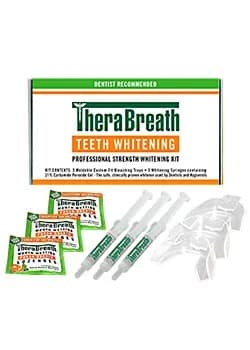Professional and At-Home Teeth Whitening
A revolution has taken place in teeth whitening products over the past few years allowing consumers to whiten their teeth quickly and safely – often in the comfort of their home.

When it comes to teeth whitening, a lot has changed in the last 10 years. There have been many developments in teeth whitening techniques which allow consumers to achieve teeth whitening quickly and safely. In fact, it's now possible to achieve dental professional teeth whitening results – in the privacy and comfort of your own home.
In this article I’ll explore the different methods of teeth whitening – both professional and at-home teeth whitening methods. I’ll explain the pros and cons of these teeth whitening methods and, hopefully, I’ll educate you to a degree that you can choose the teeth whitening method that’s right for you.
Professional, Dental Office Teeth Whitening
Mouth Trays and Peroxide - 10 to 15 years ago there was only one option if you went to the dentist to have your teeth whitened. Your dentist would take impressions of your teeth, send the impressions off to a lab, and in 5-10 days the dentist would receive back your custom fitted “mouth tray”. Then you would sit in the dental chair for 1-2 hours, with your mouth trays filled with low-strength peroxide pressed against your teeth and gums.
After 3 or 4 visits, your teeth would usually be whiter and you would be sent home with your whiter teeth – and a nice, fat $500 - $1,000 bill to pay. You would also be very likely to have sensitive teeth and gums because, back then, no one realized the damage that overexposure to peroxide could do to your gums and to someone who had sensitive teeth.
Thankfully, dental office teeth whitening procedures have come a long way in the past 10 years.
Laser Bleaching - Currently, the most popular dental office teeth bleaching procedure is known as “laser bleaching” although, technically, lasers are not actually used. This teeth whitening method uses halogen, LED or plasma arc light systems, with halogen light providing the best results according to clinical studies.
Laser bleaching is similar to the “mouth tray” and peroxide method in that a concentrated carbamide peroxide gel or hydrogen peroxide gel is applied onto your teeth. Then, for the 30 - 60 minutes you sit in a dental chair with your mouth wide open, while the light “activates” the peroxide gel to complete the teeth bleaching process in as short a time as possible.
Look, laser bleaching does work – but you still get stuck with that nice, fat, $500 - $1,000 bill to pay – and many dentists still believe that you get a whiter smile by repeated “mouth tray” procedures because the peroxide stays in contact with your teeth for longer periods of time.
Furthermore, if you are a smoker or if you drink coffee, red wine or tea, you’ll probably need to come back 6 months later for another bleaching. You could use some at-home teeth bleaching products to keep your teeth white…but then, why did you spend $500-$1000 dollars for the dental office procedure?
Similar teeth whitening procedures are even offered in shopping malls now. However, BE CAREFUL - most of the employees at these shopping mall, teeth whitening locations know as much about oral health as your pet canary. So, if you have any existing dental problems or concerns, I suggest you skip the shopping mall teeth bleaching.
Fortunately, technology has stepped in to make at-home teeth whitening possible.
At-Home Teeth Whitening
In many cases, at-home teeth whitening is now as effective as dental office treatments, in addition to being less expensive and more convenient.
Teeth Whitening Strips - This very common type of at-home teeth whitening uses strips of bleaching gel that adhere to your teeth. The main lure of this type of home teeth whitening is their simplicity of use. They're easy to apply and no preparation is necessary. Everybody loves shortcuts, right? Unfortunately, teeth whitening strips do not work as well as advertised. Why? – I’ll explain.
Teeth whitening strips press against the outer surface of your teeth. Now think about this for a second...are your teeth completely flat? Of course not - they have recesses and grooves, particularly between each tooth. So, imagine you're painting a fence, and you just slapped paint on the outside, without taking the time to paint the grooves between each wooden board. That fence would look pretty funny wouldn't it? Nicely painted on the outside, but in the grooves between each wooden board it’s still dark and dingy, with all of the old paint showing.
When you use bleaching strips, the same thing can easily happen to your teeth if you're not careful. The whiter your teeth become, the more pronounced those dingy cracks seem! Eventually it can end up looking like you have small gaps between your teeth. Definitely not the desired result!
In fact, sales of teeth whitening strips at stores were very high when first introduced – but then dipped like a roller coaster when users were frustrated by the lousy results. When “new and improved” versions of whitening strips came out, consumers again rushed to the stores to buy and sales rose again – but dropped like an anchor a second time when the “new and improved” whitening strips did not perform as expected.
Brush-on Whitening Gels - Brush-on whitening in principal is a great concept. Just brush on the formula, allow it to dry on your teeth for 10 – 30 minutes and Voila, white teeth! Sounds simple, right?...Well, I’m sorry to tell you, but there are a few problems with brush on whitening systems.
First, when you brush on the bleaching formula, it relies on the premise that it will dry on your teeth. This is great in principle, but if you get the formula wet…like with the saliva in your mouth…then it tends to rub off in places. Guess what happens if you rub off only part of the bleaching formula? Exactly – you get patchy, blotchy teeth. It reminds me of the time I painted our first apartment...don't ask!
The next flaw with most brush-on whitening, in my opinion, is the ingredients. Because this system needs to work FAST, you can’t get very good results with low concentrations of peroxide. Most of the brush-on whitening systems use 21% concentration of peroxide – which is too low to provide effective whitening using a brush-on system. For optimum, brush-on whitening, in a short period of time, a peroxide concentration of at least 30% should be used.
Mouth Trays and Whitening Gels - Up until a few years ago, teeth bleaching was a fairly complex process and had to be done at a dentist’s office. The hard part was making those custom-fitted mouth trays for each patient. For this reason alone, at-home teeth whitening with “mouth trays” was not an option.
However, most dentists agree that mouth trays with whitening gels still provide the best tooth whitening. If only there was a simpler way to get custom fitted mouth trays...well, now there is. In fact, it’s so easy now to fit mouth trays to your teeth, you can achieve professional teeth whitening results at home...
Professional Teeth Whitening at Home using Mouth Trays and Peroxide Gel
There are two important factors when it comes to achieving professional teeth whitening results at home.

First, you must use custom fitted mouth trays just like dentists use in a professional setting. This is the key to keeping the teeth whitening gel on the surface of your teeth. The longer you keep an even layer of whitening gel on your teeth the better your whitening results will be.
Second, you must use a high strength, high quality whitening gel. Most of the bleaching gels available at retail stores are of very poor quality. They've been sitting in a warehouse or on a truck for who knows how long and because they are designed to be "low cost" they have very low concentrations of active ingredients.
Most teeth whitening products use one of two types of peroxides. Both types of peroxides work on lifting stains, but there are fundamental differences between the two.
- Hydrogen Peroxide is more commonly used in dental offices. It removes staining within the teeth enamel. However, this type of Peroxide deteriorates quickly on the shelf if not used by a certain time.
- Carbamide Peroxide also known as Urea Peroxide is found in most at-home whitening kits, is more stable than hydrogen peroxide and does not deteriorate nearly as fast. This form of Peroxide also removes staining within the teeth enamel.
The bottom line is this; to achieve professional teeth whitening results at home, you should use a teeth whitening kit which uses custom fitted mouth trays combined with a 21% Carbamide Peroxide gel. This is a safe, dentist preferred and proven effective method of whitening your teeth at home.
Achieve professional teeth whitening results at home with TheraBreath whitening products!
